THE 3 BIS F - CENTRE D’ART CONTEMPORAIN
plays
INADEQUACY
with
Dora Garcia
Jean-Pierre Cometti
“I understand my activity as a research”
The 3 bis f, an artistic creation and research residence located in the Aix-en-Provence psychiatric hospital, brings together two complementary entities: the contemporary centre d’art, dedicated to plastic and visual arts, and the contemporary lieu d’arts, dedicated to choreographic projects, theatre and multidisciplinary productions. Prior to her residence at the 3 bis f, artist Doria Garcia was invited by the centre d’art to take part in a discussion with philosopher Jean-Pierre Cometti: the artist specifically recalls her relationship with the public and the interactions it generated.
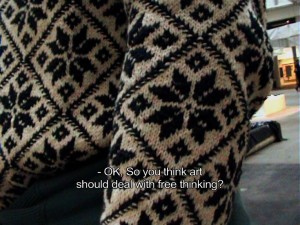 Jean-Pierre Cometti: You make a special appeal to public in your work. You already gave explanations on this subject, but I would like to take again this question from a special point of view. We often used – when speaking of artworks or artists, including when dealing with practices that would need other approaches – to pay a special attention to objects or to actions by dissociating them from contexts whithin which they take their meaning, and from audiences they address. In other words, from what appears as an experience, here or there, at that time and not another, in such or such context of actions and interactions, we only retain an abstract view, without any of the conditions that make the way it is. This tendency is related to very old habits and traditional ways of speaking or representations about art. It seems that we should have good reasons getting rid of them, and considering artworks and practices within their contex of functioning, in connexion with audiences, because of the part they play, beyond usual conventions, in what appears as art or fiction, and so on. I am interested in knowing what is your thinking about such topics, and in which extent this kind of preoccupation intervenes in your work, in your expectations.
Jean-Pierre Cometti: You make a special appeal to public in your work. You already gave explanations on this subject, but I would like to take again this question from a special point of view. We often used – when speaking of artworks or artists, including when dealing with practices that would need other approaches – to pay a special attention to objects or to actions by dissociating them from contexts whithin which they take their meaning, and from audiences they address. In other words, from what appears as an experience, here or there, at that time and not another, in such or such context of actions and interactions, we only retain an abstract view, without any of the conditions that make the way it is. This tendency is related to very old habits and traditional ways of speaking or representations about art. It seems that we should have good reasons getting rid of them, and considering artworks and practices within their contex of functioning, in connexion with audiences, because of the part they play, beyond usual conventions, in what appears as art or fiction, and so on. I am interested in knowing what is your thinking about such topics, and in which extent this kind of preoccupation intervenes in your work, in your expectations.
Dora Garcia: Well, I think that I belong to a generation we could call “contextual”. For this generation the circumstances in which the artistic “fact” happens – we speak here of creation, presentation and reception – are much more significant as the object or the event. In fact, this object or this event could very well be “anything and even nothing”. It is an excuse, some hitchcockian “MacGuffin”. His only justification is to play a role of catalyser; it could be that or anything else. We sometimes exaggerated, but I still believe in it. These are circumstances, institutions, hours, temperature, city, history, moods, information that make the artwork. After having worked in this way during a long time, I began to interest me in story as circumstance of the work. So I think sometimes that in a certain sense my work is very closed to “cultural studies” and “linguistics”, that I’m working on it because I like it, and because I think that it is here we can really understand audiences. We have to take into account that everywhere my work is described as some “study of relationships between the author, the work, and the audience”, but I think that in fact we could say only between “the author and the audience”, and that this is this relationship between “the author and the audience” that makes work, I mean this “third thing” that is created between both, even if one of the two don’t know anything of such a system at all.
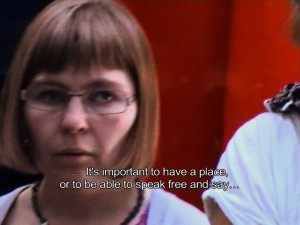 JPC. Fine. You bring art back to its contingency. But I would be interested in asking you some more precisions about two aspects of what you say. First you suggest that art consists in the way an artist and her public get into interaction. If art is in the outcomes of this interaction between both (what you call this “third thing”)? Don’t you think that such a conception should lead us to change our mind about art? But could you also explain what you mean when you describe your work as something close to “cultural studies” or to “linguistics”? Does it mean that your actions intend to get some effects related to what cultural studies try to deal with about genders, for instance, nature and culture, and so on? Is it that art can be a means for changing our ways of reacting, of perceiving or thinking? And since “this object or this event might be anything and perhaps nothing”, is art only a means among others?
JPC. Fine. You bring art back to its contingency. But I would be interested in asking you some more precisions about two aspects of what you say. First you suggest that art consists in the way an artist and her public get into interaction. If art is in the outcomes of this interaction between both (what you call this “third thing”)? Don’t you think that such a conception should lead us to change our mind about art? But could you also explain what you mean when you describe your work as something close to “cultural studies” or to “linguistics”? Does it mean that your actions intend to get some effects related to what cultural studies try to deal with about genders, for instance, nature and culture, and so on? Is it that art can be a means for changing our ways of reacting, of perceiving or thinking? And since “this object or this event might be anything and perhaps nothing”, is art only a means among others?
DG. Well, I don’t say that art consists in the way an artist and her public get into interaction; I only say that art is produced within this interaction, or because of it. It is the basic condition of art- it is a condition, a circumstance, a place, but art is not equal to interaction. Then, I cannot really say if such a conception should lead us to change our mind about art, because I ignore what people think of art. I suspect, that in many cases art is linked to an object and to the virtuosity of producing that exceptional object- if this is the case, indeed we should change our mind about art. I suspect that in many cases art is linked to status quo, it is the ultimate luxury object, because it is extremely rare and it requires to enter a certain circuit or brotherhood to have intellectual access to it- in this case, indeed I think we should change our mind about art. But I think as well that perhaps my first answer gave way to a misunderstanding. Even if I think that art is all about context (does not exist outside a certain place, a certain time, a certain onlooker) and all about audience (it is in relation to the audience the artist determines what has to be done), I think art is also all about the intention of an individual, the artist. It is an effort, it is born from a deep conviction and desire, from one single individual.
What I mean by “cultural studies, linguistics” is that from the conviction that thought is language I try to use this as the key to understand how society functions. This is what originates my work, the will to understand. So I understand my activity first and foremost as a research, and in this activity it finds a sense. I find beauty in this activity too- a very special type of beauty, one that touches me deeply.
Is art a means among others? for what? it is indeed a means among others to give sense to existence, to give consolation.
“This object or this event might be anything and perhaps nothing”- with this I simply mean- art is not related to any specific object, material, or situation. It is profoundly true that anything can be art. Can. Potentially, anything can. Even nothing can. Sometimes, I explain art to my students as a “mood”, a “function”- an intentionality that is projected on “anything, and even nothing”.
JPC. If I’m not mistaken, in such an experience what pertains to art has its source in an intention which gives it its special meaning. I am afraid it is not easy to define what « intention » refers to, but the best thing we have to do is probably to pay attention to actions, practices and their connected objects. You say that for you the main thing is to “understand”, and to see how society functions. I guess that the effects of your acting upon the public are specially relevant from this point of view. That art helps us to “understand” – understand others, understand the way the world is – seems to me a very significant point in the present conditions of culture and social life. How do you see exactly your role as an artist? Do you see it as a critical role? Could you explain your own conception in the light of one of your actions?
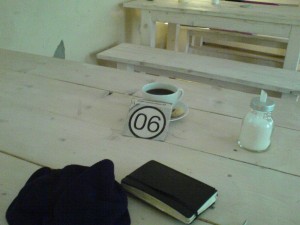 DG. I believe, in a quite honest and naive way, that the dismantling of conventions helps us to live more intensely. Conventions are created each day, and what is unconventional now will be conventional ten minutes later. Conventional here means repetition of a structure because it is generally accepted, it is what guarantees the status quo. Dismantling conventions is a way to understand them and understand the culture and the subculture that created those conventions. So yes, art creates a form of understanding, even if I believe the function of art is not being understood, but rather to puzzle, or better: to marvel, in the best of cases.
DG. I believe, in a quite honest and naive way, that the dismantling of conventions helps us to live more intensely. Conventions are created each day, and what is unconventional now will be conventional ten minutes later. Conventional here means repetition of a structure because it is generally accepted, it is what guarantees the status quo. Dismantling conventions is a way to understand them and understand the culture and the subculture that created those conventions. So yes, art creates a form of understanding, even if I believe the function of art is not being understood, but rather to puzzle, or better: to marvel, in the best of cases.
A good example I believe is “The Beggars Opera” (2007), a performance I defined as “theater play in real time and public space”- for Münster Sculpture Projects.
In this work, I created a tool to dismantle the conventions of art in public space. I wanted to puzzle people, to leave them at a loss about how to react in front of the artwork “the beggar”. Humor, enjoyment, intensity was created by the inability of this work to fit the conventions of art in public space and the impossibility of the audience to adopt the well-trodden behaviour of “audience-in-front-of-an-artwork”. The work consisted of a character, Charles Filch, a secondary character from the Bertolt Brecht play and novel The Three Penny Opera, which “came alive” in Münster and became a citizen of the streets of Münster during the three months of the exhibition. It had all the qualities one should ask of an artwork in public space (existed in public space, changed the perception of it), and at the same time it was obviously a person- personnage and to reduce it to the condition of a number on an outdoor sculpture map was absurd.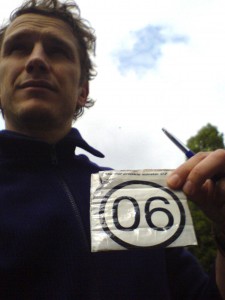
But, when I was preparing the character together with the three actors who were going to play it, I remember I told them: it is good to dismantle the conventions, it is good to break the safety of the exhibition, it is good to reformulate the roles of audience and artwork, but in the end, what will tell if we succeeded or not is if we are able to tell a good story, with a believable character, a story that is truly alive and truly touches people and one that is able to react and to adapt to the contingencies of the everyday in public space.
JPC. There are different sort of conventions. What is interesting is that the audience’s reactions depend on expectations connected with general beliefs – and therefore of general and common conventions —, but also on beliefs and desires own to one group or to one community, and also on aesthetic conventions and habits. They may be different depending on the audience. In 3bisF, which is not as you know a standard art place, you’ll have to deal with a special audience, which is not the one of public space of galeries or of museums. I guess it will be for you the occasion of a special experience. How do you see it in relation with what you told before?
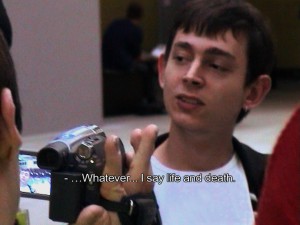 DG. I have worked a few times before in extremely loaded contexts and, what I think is more pertinent here, I have worked with “special” groups of people. One of the things that attracted me to work with “outsider” artists is indeed the discussion that it could create among “insiders”- because, I think, it puts in evidence a lot of received ideas, hypocrisy, and conventions about “correctness”. But in the end, the real reason why I worked with those “outsider” artists is because I liked their work very much. I did a performance with “Glad Theater”, in Copenhagen, which is a self-managed theater by psychical handicapped people; I have worked with different theater groups with people “with and without” psychiatric experience. There are two things that made me wish to work together with them, one, and unconditional, their work was good; and two, the reason why they made theater was not to construct a career, but to survive.
DG. I have worked a few times before in extremely loaded contexts and, what I think is more pertinent here, I have worked with “special” groups of people. One of the things that attracted me to work with “outsider” artists is indeed the discussion that it could create among “insiders”- because, I think, it puts in evidence a lot of received ideas, hypocrisy, and conventions about “correctness”. But in the end, the real reason why I worked with those “outsider” artists is because I liked their work very much. I did a performance with “Glad Theater”, in Copenhagen, which is a self-managed theater by psychical handicapped people; I have worked with different theater groups with people “with and without” psychiatric experience. There are two things that made me wish to work together with them, one, and unconditional, their work was good; and two, the reason why they made theater was not to construct a career, but to survive.
Dora Garcia , born 1965. Works and lives in Barcelona. Her conceptual work consists in texts, photographs, performances and installations in specific sites. She will be in residency at the centre d’art 3 bis f early 2013, in the frame of an “AEM” euro-mediteranean workshop in partnership with Marseille Provence, 2013 European capital of culture.
Jean-Pierre Cometti, philosopher and translator, is the author of several studies on art and the current state of art. He recently published Art et facteurs d’art, in the collection “Aesthetica”, at the Presses Universitaires de Rennes.
Further reading:
3 bis f, lieu d’arts contemporains, Aix-en-Provence
Jean-Pierre Cometti
Dora Garcia
